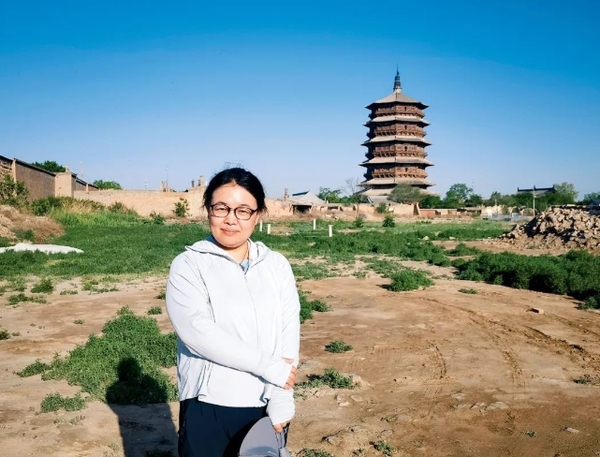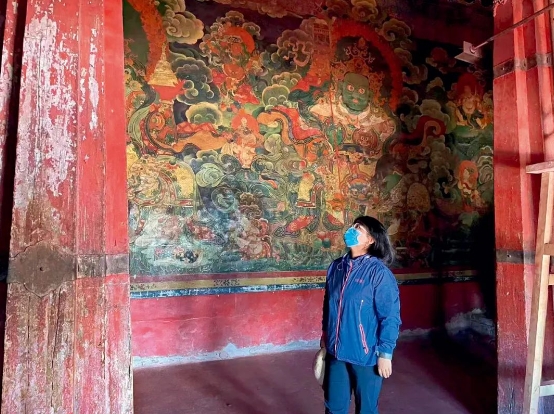Reading 'Heartbeats' of Historic Architecture

"We are a group of lucky researchers who work on historic architecture. We conduct studies into ancient constructions, as if doing 'physical examinations' on the architecture. Meanwhile, we try to hear — and read — the 'heartbeats' of architecture, which have existed over hundreds, or even thousands, of years." That is how Yang Na describes her career.
Yang is a professor with Potala Palace Structure and Monitor Research Center, under Beijing Jiaotong University. Yang has used sci-tech approaches as she has led her team in researching ancient architecture, to monitor and/or detect the conditions of the constructions.
"Since October 2012, when the first phase of the structure monitoring system for Potala Palace was formally put into use, almost all of the key parts of the palace's wooden structures have been monitored, with great caution. It is like providing 'physical examinations' on architecture. We need to know if the architecture's condition is well, where its 'pains' may come from, and when and in what way we should give it proper 'medicine.' We seek answers to such questions based on the data we have collected by monitoring sensors installed in the palace," Yang explains.
Potala Palace is located on Red Mountain, at an altitude of 3,700 meters, in Lhasa, capital of southwest China's Xizang Autonomous Region. The palace was built by Tibetan King Songtsen Gampo in the seventh century. It is one of the most popular tourist attractions in Xizang, and it is a World Heritage Site.
Yang was astonished by the palace during her first visit to the site, in 2007. She was impressed not only by the architecture's unique ethnic features, its colors and its scale, but also by its murals, decorations and, more importantly, by the architecture's historic significance.

Yang recalls how staff at Potala Place had foreseen the potential challenge of preserving the ancient architecture, which they expected to become a must-visit tourist attraction after July 2006, when the Qinghai-Tibet Railway (linking Lhasa and Xining, capital of northwest China's Qinghai Province) opened to the public. Yang and her team were asked to help protect Potala Palace.
The palace had undergone two major renovations, the first in 1989 and the other in 2002. Before the renovations, the walls in the basement had become seriously damaged with cracks, and many of the wooden supports had become plagued by worms. A plan to monitor the structure was developed by Yang and her team; the plan had three phases, and it covered areas in the basement, the interior, and the exterior.
Sensors were attached to the walls, floors and wooden supports, to monitor and record the humidity in the rooms, the width of cracks, the inclination of the walls and supports, and the impacts of tourists on the wooden structures. The sensors were strategically placed to avoid possible damage to the palace's original structure.
During the past decade, more than 10 million sets of data have been transmitted, online, from Potala Palace to Yang's Beijing-based office. "The sensors form an electrocardiogram, or a CT (computed tomography) scan, for architecture. By monitoring the architecture, and analyzing data, we are able to read the 'heartbeats' of an ancient construction," Yang says.
In recent years, Yang has led her team in the provision of "physical examinations" of several renowned ancient constructions, including Wooden Pagoda, in Yingxian, a county in north China's Shanxi Province.
Wooden Pagoda in Yingxian, built in 1056, is the oldest multistory wooden structure in the world. "Due to the impacts of natural disasters and human factors, the pagoda's deformation has continuously increased. Any disaster, which may occur all of sudden, will possibly affect the safety of this pagoda," Yang reportedly said in 2018, as she and her team conducted a test on the pagoda.
"One of my best memories of Wooden Pagoda was when I put my hand on a section of the railing inside the construction. I felt my heartbeat slow, as if I were having a 'conversation' with a treasure of history, represented by this ancient architecture," Yang says.
(Women of China English Monthly September 2024)
Editor: Wang Shasha
Please understand that womenofchina.cn,a non-profit, information-communication website, cannot reach every writer before using articles and images. For copyright issues, please contact us by emailing: website@womenofchina.cn. The articles published and opinions expressed on this website represent the opinions of writers and are not necessarily shared by womenofchina.cn.?






.jpg)

 WeChat
WeChat Weibo
Weibo 京公綱安備 11010102004314號
京公綱安備 11010102004314號